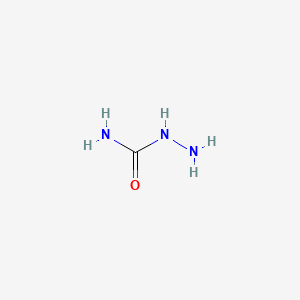D0558 | semicarbazide
| Toxicity | Dose | Time | Species | Model | Method | Action | Positive criterion | Reference |
|---|---|---|---|---|---|---|---|---|
| ELECTRON TRANSPORT CHAIN | affect | 167 | ||||||
| ELECTRON TRANSPORT CHAIN | decrease | 167 | ||||||
| Target | Dose | Time | Species | Model | Method | Action | Positive criterion | Reference |
|---|---|---|---|---|---|---|---|---|
| Quinol--cytochrome-c reductase | inhibitor | 167 | ||||||
| Cytochrome c oxidase | nonheme inhibitor | 167 | ||||||
| Pictogram | Signal | Statements | Precautionary Statement Codes |
|---|---|---|---|
  |
Danger |
Aggregated GHS information provided by 71 companies from 2 notifications to the ECHA C&L Inventory. Each notification may be associated with multiple companies. H301 (100%): Toxic if swallowed [Danger Acute toxicity, oral] H315 (53.52%): Causes skin irritation [Warning Skin corrosion/irritation] H319 (53.52%): Causes serious eye irritation [Warning Serious eye damage/eye irritation] H335 (53.52%): May cause respiratory irritation [Warning Specific target organ toxicity, single exposure Respiratory tract irritation] Information may vary between notifications depending on impurities, additives, and other factors. The percentage value in parenthesis indicates the notified classification ratio from companies that provide hazard codes. Only hazard codes with percentage values above 10% are shown. |
P261, P264, P270, P271, P280, P301+P310, P302+P352, P304+P340, P305+P351+P338, P312, P321, P330, P332+P313, P337+P313, P362, P403+P233, P405, and P501; (The corresponding statement to each P-code can be found at the GHS Classification page.) |
| Organism | Test type | Route | Dose (normalized dose) | Effect | Source |
|---|---|---|---|---|---|
| mouse | LD50 | intraperitoneal | 145mg/kg (145mg/kg) | Farmakologiya i Toksikologiya Vol. 24, Pg. 623, 1961. | |
| rat | LD | intraperitoneal | > 98mg/kg (98mg/kg) | vascular: strictira; cjamges om vesse;s | Toxicology and Applied Pharmacology. Vol. 155, Pg. 237, 1999. |
| mouse | LD50 | subcutaneous | 167mg/kg (167mg/kg) | Acta Biologica et Medica Germanica. Vol. 21, Pg. 635, 1968. | |
| mouse | LD50 | oral | 225mg/kg (225mg/kg) | Arzneimittel-Forschung. Drug Research. Vol. 10, Pg. 686, 1960. | |
| rat | LDLo | oral | 10mg/kg (10mg/kg) | National Academy of Sciences, National Research Council, Chemical-Biological Coordination Center, Review. Vol. 5, Pg. 44, 1953. | |
| rabbit | LDLo | oral | 400mg/kg (400mg/kg) | Farmakologiya i Toksikologiya Vol. 24, Pg. 623, 1961. | |
| 1-azanylurea | 37QUC23K2X | 4-03-00-00177 (Beilstein Handbook Reference) |
| 4426-72-6 | 51433-48-8; | 57-56-7 |
| A518 | A831506 | AKOS005716900 |
| Aminoharnstoff | Aminomocovina | Aminomocovina [Czech] |
| Aminourea | BBL012207 | BDBM50108606 |
| BRN 0506319 | C02077 | CARBAMOHYDRAZONIC ACID |
| CCG-205173 | CHEBI:28306 | CHEMBL903 |
| CTK1H0495 | CTK1H0745 | CTK4I8064 |
| Carbamic acid, hydrazide | Carbamidsaeurehydrazid | Carbamoylhydrazine |
| Carbamylhydrazine | Carbazamide | DTXSID7043823 |
| DUIOPKIIICUYRZ-UHFFFAOYSA-N | EINECS 200-339-6 | FT-0655580 |
| HYDRAZINECARBOXAMIDE | Hydrazine, carbamoyl- | Hydrazinecarboxamide, hydrochloride (1:1) |
| Hydrazinecarboximidicacid (9CI) | KS-00001922 | LS-144844 |
| Lopac-S-2201 | Lopac0_001096 | MCULE-8490374775 |
| NCGC00015934-01 | NCGC00015934-02 | NCGC00015934-03 |
| NCGC00015934-04 | NCGC00015934-05 | NCGC00091589-02 |
| Q417535 | RW2383 | SC-18463 |
| STL163549 | Semicarbazide | Semicarbazide, 6 wt% on Silica gel |
| Semicarbazide, 6 wt. % (on silica gel) | Semikarbazid | Semikarbazid [Czech] |
| UNII-37QUC23K2X | Urea, amino- | ZINC8035043 |
| amino-urea | carbamic acid hydrazide | isosemicarbazide |

